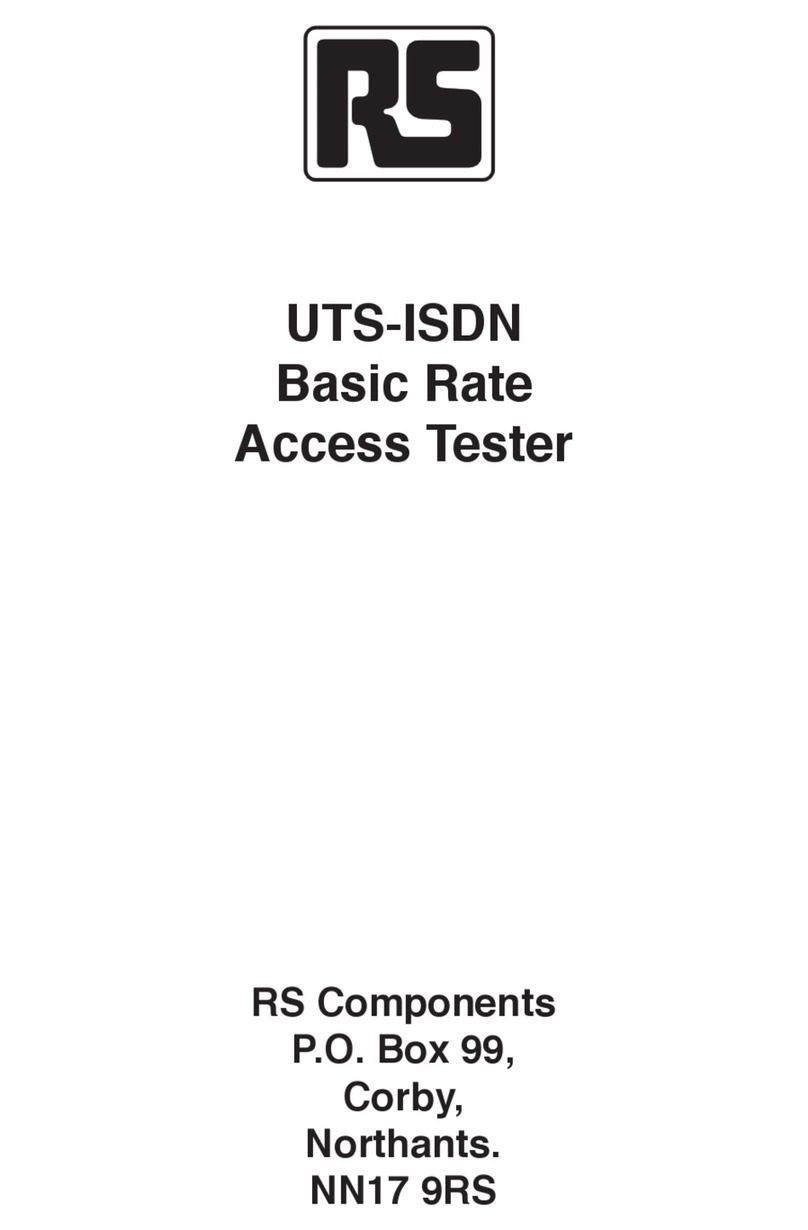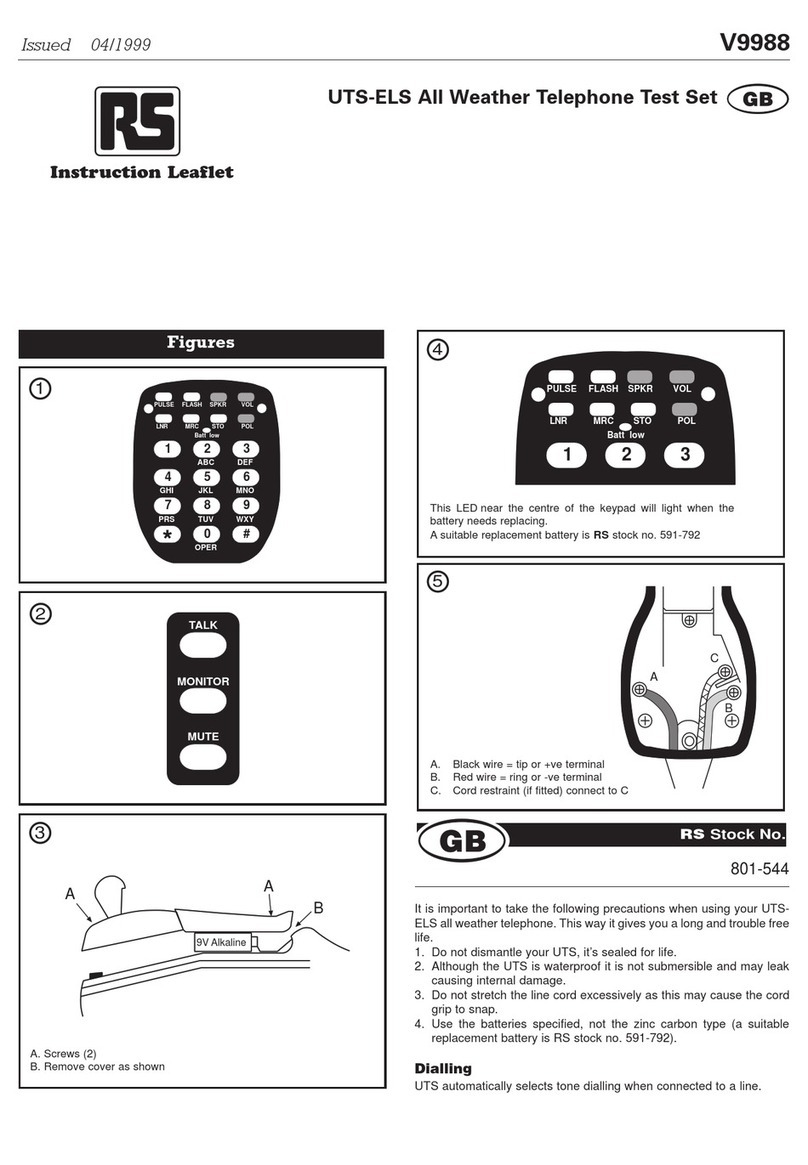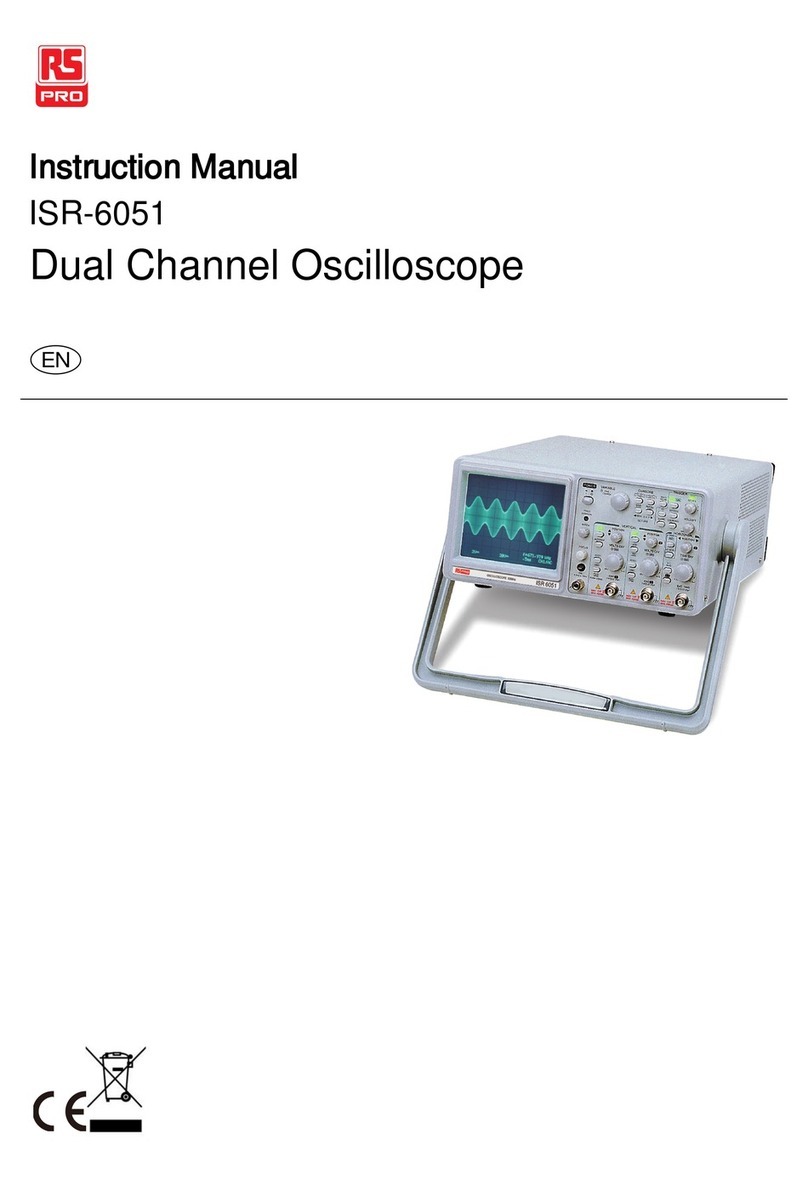2
215-6391 Geschirmtes Prüfgerät II
450-758 Adapterleitung/Kupplungsstück
Dieses RS Prüfgerät für Datenverkabelungen dient zur Überprüfung
von zwei-, drei- und vierpaarigen Sprach- und Datenkanälen und zur
Anzeige von Verkabelungsfehlern. Die kontinuierliche LED-
Sequenzanzeige gibt sofort Aufschluss über Kurzschlüsse, offene
Anschlüsse, verpolte und falsch angeschlossene Leitungen.
Die Basis- und Fernstationen lassen sich unabhängig voneinander
einsetzen, um eine durchgängige Überprüfung der installierten
Verkabelung zu ermöglichen. Sie können das Prüfgerät verwenden, um
jeden Kanal bis zum Hauptleitungsverteiler zurückzuverfolgen,
Querverbindungen zu überprüfen und alle Leitungskabel zu testen.
Fehlersuche
Verbindung vom Hauptleitungsverteiler zum Prüfpunkt
Falls Sie eine große Zahl von Tests vornehmen möchten oder falls die
Tests über erhebliche Entfernungen durchgeführt werden sollen, ist es
empfehlenswert, eine weitere Person hinzuzuziehen, mit der Sie über
eine Funk- oder Telefonverbindung Kontakt aufnehmen können.
Damit die Anschlussbuchsen des Prüfgeräts geschützt werden, wird
empfohlen, dieAdapterleitung (RS Best.-Nr. 450-758) an das Prüfgerät
anzuschließen und die Verbindung mit dem zu überprüfenden Kanal
dann über dieseAdapterleitung herzustellen und zu trennen. Auf diese
Weise verringern Sie den Verschleiß am Kontaktsatz des Prüfgeräts
und stellen einen langen und zuverlässigen Betrieb des Prüfgeräts
sicher. Zur Adapterleitung (RS Best.-Nr. 450-758) gehört auch ein
Kupplungsstück von RJ45-Buchse auf RJ45-Buchse, sodass Sie mit
diesem Prüfgerät Kanäle überprüfen können, die mit Buchsen und
Steckern terminiert sind.
1. Wählen Sie am Prüfgerät die richtige Buchse für das
Verdrahtungsschema, das überprüft werden soll.
2. Schließen Sie die Fernstation an den Prüfpunkt an.
3. Schließen Sie die Basisstation an den Hauptleitungsverteiler an.
4. Lesen Sie die Diagnoseinformationen an den LEDs ab (siehe
folgende Tabelle).
Tabelle 1
Verkabelungen nach USOC, 568A und 568B
Tabelle 2
Sie können mit dem Prüfgerät Paare nach den Angaben in der
folgenden Tabelle überprüfen:
Geschirmte Prüfung
Neben den Standardmöglichkeiten zur Fehlersuche bietet Ihnen das
geschirmte Prüfgerät auch die Möglichkeit, die Integrität von STP-
Kabeln (geschirmten verdrillten Paaren) zu überprüfen.
Bei solchen Prüfungen ist es jedoch empfehlenswert, ein geschirmtes
Anschlusskabel (RS Best.-Nr. 365-9043) für die Verbindung zwischen
dem Prüfgerät und den Kanalbuchsen zu verwenden.
1. Schließen Sie die Fernstation und die Basisstation an den lokalen
Auslass bzw. an den Hauptleitungsverteiler an.
2. Bringen Sie den Schirmungsschalter der Basisstation in die Stellung
OFF (Aus) und überprüfen Sie dann die Durchgängigkeit des Paars
entsprechend den Angaben in Tabelle 1.
3. Bringen Sie den Schirmungsschalter der Basisstation in die Stellung
TEST und überprüfen Sie dann die Durchgängigkeit der Schirmung
auf folgende Weise:
4. Halten Sie den Schirmungsschalter der Fernstation in der Stellung
BRK und überzeugen Sie sich, dass die grüne LED OK an beiden
Stationen erlischt.
Batteriewechsel
Legen Sie die Batterie folgendermaßen in die Basisstation ein:
1. Entfernen Sie die Schrauben der Batterieabdeckung auf der
Rückseite der Basisstation mit einem Kreuzschlitzschraubendreher
der Größe "O". Legen Sie die Schrauben zur Seite.
2. Entfernen Sie die alte 9V-Alkalibatterie des Typs PP3 (E-Block) und
legen Sie eine neue Batterie des gleichen Typs ein - z.B. RS Best.-
Nr. 394-9059.
3. Setzen Sie die Batterieabdeckung wieder ein und ziehen Sie die
Schrauben wieder fest. Achten Sie dabei darauf, dass Sie die
Schrauben nicht zu fest anziehen.
Vorsicht! Verwenden Sie dieses Prüfgerät keinesfalls für Prüfungen
im NETZ oder an STROMFÜHRENDEN Schaltungen.
RS Components haftet nicht für Verbindlichkeiten oder Schäden jedweder Art (ob auf
Fahrlässigkeit von RS Components zurückzuführen oder nicht), die sich aus der
Nutzung irgendwelcher der in den technischen Veröffentlichungen von RS
enthaltenen Informationen ergeben.
Basisstation Fernstation
Grüne LED Nr. 1 und LED OK leuchten Grüne LED OK leuchtet
USOC
6-Draht 8-Draht 568A 568B
4 5 5 5 Paar 1 (LED Nr. 1)
3 4 4 4
2 3 3 1 Paar 2 (LED Nr. 2)
5 6 6 2
1 2 1 3 Paar 3 (LED Nr. 3)
6 7 2 6
8 7 7 Paar 4 (LED Nr. 4)
1 8 8
Basisstation Fernstation Diagnose
LED leuchtet (grün) LED leuchtet (grün) Einwandfreier Kanal
LED leuchtet (grün) LED leuchtet (rot) Verpolung
LED leuchtet (grün) LED leuchtet nicht Kurzschluss im Paar
2 LEDs leuchten (grün) 2 LEDs leuchten Kurzschluss zwischen
Paaren
LED leuchtet nicht LED leuchtet nicht Offener Anschluss
LED nicht in Sequenz LED nicht in Sequenz Vertauschte
Paare




























